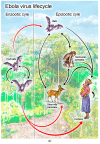Environmental Risk Assessment for rVSVΔG-ZEBOV-GP, a Genetically Modified Live Vaccine for Ebola Virus Disease
- PMID: 33352786
- PMCID: PMC7767225
- DOI: 10.3390/vaccines8040779
Environmental Risk Assessment for rVSVΔG-ZEBOV-GP, a Genetically Modified Live Vaccine for Ebola Virus Disease
Abstract
rVSVΔG-ZEBOV-GP is a live, attenuated, recombinant vesicular stomatitis virus (rVSV)-based vaccine for the prevention of Ebola virus disease caused by Zaire ebolavirus. As a replication-competent genetically modified organism, rVSVΔG-ZEBOV-GP underwent various environmental evaluations prior to approval, the most in-depth being the environmental risk assessment (ERA) required by the European Medicines Agency. This ERA, as well as the underlying methodology used to arrive at a sound conclusion about the environmental risks of rVSVΔG-ZEBOV-GP, are described in this review. Clinical data from vaccinated adults demonstrated only infrequent, low-level shedding and transient, low-level viremia, indicating a low person-to-person infection risk. Animal data suggest that it is highly unlikely that vaccinated individuals would infect animals with recombinant virus vaccine or that rVSVΔG-ZEBOV-GP would spread within animal populations. Preclinical studies in various hematophagous insect vectors showed that these species were unable to transmit rVSVΔG-ZEBOV-GP. Pathogenicity risk in humans and animals was found to be low, based on clinical and preclinical data. The overall risk for non-vaccinated individuals and the environment is thus negligible and can be minimized further through defined mitigation strategies. This ERA and the experience gained are relevant to developing other rVSV-based vaccines, including candidates under investigation for prevention of COVID-19.
Keywords: ERA; ERVEBO®; GMO; Zaire ebolavirus; environmental impact; rVSV; recombinant vaccine; shedding; vesicular stomatitis virus; viremia.
Conflict of interest statement
J.G.T., B-A.G.C., S.A.D., W.L., L.W., and J.W. are employees of Merck Sharp & Dohme Corp., a subsidiary of Merck & Co., Inc., Kenilworth, NJ, USA, who may own stock and/or hold stock options in Merck & Co., Inc., Kenilworth, NJ, USA. U.J. served as a consultant to Merck Sharp & Dohme Corp., a subsidiary of Merck & Co., Inc., Kenilworth, NJ, USA, in connection with the work described in this manuscript. Employees of the funder were involved in the design of the original research summarized in this article; in the collection, analyses and interpretation of data; and in the writing of the manuscript. The company had no role in the design of the study; in the collection, analyses, or interpretation of data; in the writing of the manuscript, and in the decision to publish the results.
Figures






Similar articles
-
Immunogenicity and Vaccine Shedding After 1 or 2 Doses of rVSVΔG-ZEBOV-GP Ebola Vaccine (ERVEBO®): Results From a Phase 2, Randomized, Placebo-controlled Trial in Children and Adults.Clin Infect Dis. 2024 Apr 10;78(4):870-879. doi: 10.1093/cid/ciad693. Clin Infect Dis. 2024. PMID: 37967326 Free PMC article. Clinical Trial.
-
Cellular and humoral immunity to Ebola Zaire glycoprotein and viral vector proteins following immunization with recombinant vesicular stomatitis virus-based Ebola vaccine (rVSVΔG-ZEBOV-GP).Vaccine. 2023 Feb 17;41(8):1513-1523. doi: 10.1016/j.vaccine.2023.01.059. Epub 2023 Jan 31. Vaccine. 2023. PMID: 36725433 Free PMC article.
-
Characterization of rVSVΔG-ZEBOV-GP glycoproteins using automated capillary western blotting.Vaccine. 2020 Oct 21;38(45):7166-7174. doi: 10.1016/j.vaccine.2020.08.001. Epub 2020 Sep 18. Vaccine. 2020. PMID: 32951937
-
Lessons Learned from the Development and Roll-Out of the rVSVΔG-ZEBOV-GP Zaire ebolavirus Vaccine to Inform Marburg Virus and Sudan ebolavirus Vaccines.Vaccines (Basel). 2022 Sep 1;10(9):1446. doi: 10.3390/vaccines10091446. Vaccines (Basel). 2022. PMID: 36146524 Free PMC article. Review.
-
Translational success of fundamental virology: a VSV-vectored Ebola vaccine.J Virol. 2024 Mar 19;98(3):e0162723. doi: 10.1128/jvi.01627-23. Epub 2024 Feb 2. J Virol. 2024. PMID: 38305150 Free PMC article. Review.
Cited by
-
When synthetic biology meets medicine.Life Med. 2024 Mar 6;3(1):lnae010. doi: 10.1093/lifemedi/lnae010. eCollection 2024 Feb. Life Med. 2024. PMID: 39872399 Free PMC article. Review.
-
Environmental Risk Assessment of Recombinant Viral Vector Vaccines against SARS-Cov-2.Vaccines (Basel). 2021 May 3;9(5):453. doi: 10.3390/vaccines9050453. Vaccines (Basel). 2021. PMID: 34063733 Free PMC article. Review.
-
Oncolytic Viruses: An Inventory of Shedding Data from Clinical Trials and Elements for the Environmental Risk Assessment.Vaccines (Basel). 2023 Sep 1;11(9):1448. doi: 10.3390/vaccines11091448. Vaccines (Basel). 2023. PMID: 37766125 Free PMC article. Review.
-
High dose of vesicular stomatitis virus-vectored Ebola virus vaccine causes vesicular disease in swine without horizontal transmission.Emerg Microbes Infect. 2021 Dec;10(1):651-663. doi: 10.1080/22221751.2021.1903343. Emerg Microbes Infect. 2021. PMID: 33719915 Free PMC article.
-
Environmental impact assessment of COVID-19 therapeutic solutions. A prospective analysis.Sci Total Environ. 2021 Jul 15;778:146257. doi: 10.1016/j.scitotenv.2021.146257. Epub 2021 Mar 10. Sci Total Environ. 2021. PMID: 33721651 Free PMC article.
References
-
- Canady D., Weil N.C., Miller C., Shantha J.G., Bastien G., Yeh S. Ophthalmic and Psychosocial Sequelae in Ebola Virus Disease Survivors: Ongoing Need for Health Systems Strengthening across Disciplines. Expert Rev. Anti. Infect. Ther. 2020:1–3. doi: 10.1080/14787210.2020.1808461. - DOI - PMC - PubMed
-
- Etard J.F., Sow M.S., Leroy S., Toure A., Taverne B., Keita A.K., Msellati P., Magassouba N., Baize S., Raoul H., et al. Multidisciplinary Assessment of Post-Ebola Sequelae in Guinea (Postebogui): An Observational Cohort Study. Lancet Infect. Dis. 2017;17:545–552. doi: 10.1016/S1473-3099(16)30516-3. - DOI - PubMed
-
- Mattia J.G., Vandy M.J., Chang J.C., Platt D.E., Dierberg K., Bausch D.G., Brooks T., Conteh S., Crozier I., Fowler R.A., et al. Early Clinical Sequelae of Ebola Virus Disease in Sierra Leone: A Cross-Sectional Study. Lancet Infect. Dis. 2016;16:331–338. doi: 10.1016/S1473-3099(15)00489-2. - DOI - PMC - PubMed
Publication types
Grants and funding
LinkOut - more resources
Full Text Sources
Research Materials

